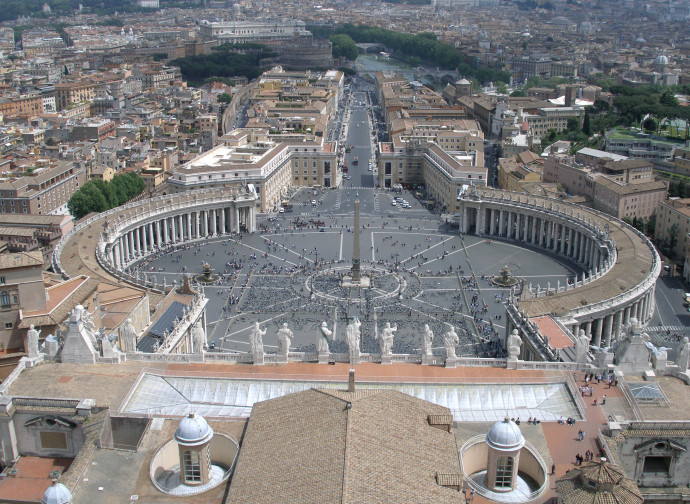Catholics are increasing worldwide. Except in Europe
On the occasion of World Mission Day, 20 October, Fides published a report on the state of the Church in the world. Nearly 14 million more Catholics, but numbers are falling in Europe.

On occasion of World Mission Day, the 98th this year, celebrated on 20 October, the Fides news agency published its yearly dossier on the state of the Catholic Church in the world. It contains data and statistics updated to 31 December 2022 taken from the latest Vatican ‘Statistical Yearbook of the Church’ and related to Church members, pastoral structures, activities carried out in the health, welfare and educational spheres subdivided by continent - Africa, America, Asia, Europe, Oceania - and compared with those of 2021.
The first, general figure concerns the total number of Catholics. Out of a world population of 7,838,944,000 there are 1,389,573,000, that is 13,721,000 more than the previous year; 17.7% of the total, a slight increase of 0.03%. The increase occurred on all continents with the exception of Europe where there was a decrease of 474,000. The greatest growth occurred in Africa where 2022 ended with 7,271,000 more Catholics.
While the number of Catholics increased, the number of priests decreased, albeit slightly, to 407,730, 142 fewer: 279,171 are diocesans (-439) and 128,559 are religious (+297). The largest reduction occurred in Europe, (- 2,745), followed by America, (-164), while notable increases occurred in Africa and Asia, (+ 1,676 and +1,160 respectively). The number of bishops, on the other hand, increased by 13. The total is 5,353: 2,682 diocesans and 2,671 religious. The number of permanent deacons also increased, reaching 50,159 (+974).
The number of non-priest religious, women religious, major seminarians and minor seminarians decreased. Non-priestly religious decreased to 49,414 (-360): the increases in America (+27) and Asia (+251) were not enough to compensate for the decreases in Europe (-382), Africa (-229) and Oceania (-27). The number of female religious went from 608,958 to 599,228 (-9,730). This is a trend that has been ongoing for some time. There were increases in Africa (+1,358) and Asia (+74), but Oceania lost 225, America 1,358 and Europe even 7,012. The diocesan and religious major seminarians are 108,481 (-1,417): they increased only in Africa (+726) and Oceania (+12), while they decreased in Asia (-375), Europe (-859) and America (-921). There were 95,161 diocesan and religious minor seminarians (-553). They increased in Africa (+1,065), while there were 475 fewer in Asia, 978 in America. 153 in Europe and 12 in Oceania.
Finally, the dossier reports other data concerning the Church's commitment in the school and health sectors. In the world, the Church supports 74,322 kindergartens with 7,622,480 pupils; 102,189 primary schools with 35,729,911 pupils; 50,851 secondary and high schools with 20,566,902 pupils. Another 2,460,993 pupils study in higher institutions and 3,925,393 are university students. Health, charitable and welfare institutions total 102,409 and include: 5,420 hospitals; 14,205 dispensaries; 525 leprosy hospitals; 15,476 homes for the elderly, chronically ill and disabled; 10,589 kindergartens; 10,500 marriage counselling centres; 3,141 social education or re-education centres and 33,677 other institutions.
In order to illustrate the trends over a broader time span, and also in view of the forthcoming Jubilee, this year Fides has also added an appendix to the dossier that provides a summary of the comparative data for the years from 1998 to 2022, which however does not go into the details of the individual continents. In the 25 years considered, the number of Catholics has been steadily increasing and in percentage terms has risen from 17.4% in 1998 to 17.8% in 2014 to the current 17.7. However, as much as the number of Catholics has increased, the administration of the sacrament of Baptism has not: from 17,932,891 baptisms administered in 1998 to 13,327,037 in 2022. As for priests and religious, the number of the former has grown from 404,628 in 1998 to the current 407,430. The most significant figure is the decrease of women religious: from 814,779 in 1998 to the current 599,228.
On the occasion of World Mission Day, Pope Francis as usual sent a message which this year is entitled: ‘Go and invite everyone to the banquet (cf. Mt 22:9). The theme deals with the Gospel parable of the wedding banquet to which the king's guests refuse to go, after which the king sends his servants saying: ‘go now to the crossroads and all those whom you find, call them to the wedding’. ‘Reflecting on this key-word, in the context of the parable and the life of Jesus,’ explains the Pontiff, ’we can highlight some important aspects of evangelisation. They prove to be particularly relevant for all of us, disciples-missionaries of Christ, in this final phase of the synodal journey which, in accordance with the motto ‘Communion, participation, mission’, will have to relaunch the Church towards its priority commitment, that is, the proclamation of the Gospel in the contemporary world'.
«Aggressive secularism and Islam suffocate Catholics»
The churches that have been burned in France are only the tip of the iceberg of a climate of hostility against Christians. There is an obvious convergence between secularist forces and the ever more significant presence of Islam. While mosques are being built, Christian churches – whose maintenance is the responsibility of the State – are being abandoned and closed. The Bishop of Montauban, Bernard Ginoux, says with regard to Hagia Sophia: “The Abu Dhabi agreement has been abandoned; Erdogan is implementing a policy of expansion and hegemony in the Mediterranean in the name of Islam; dialogue with him is impossible.”


